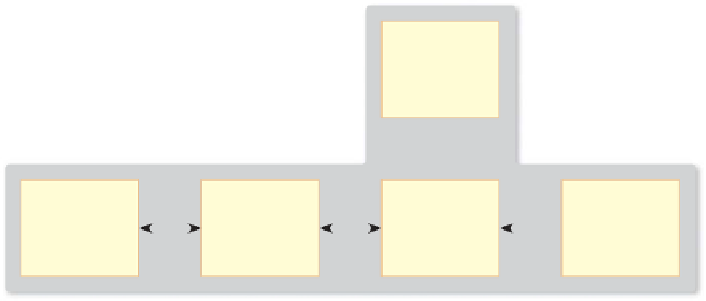Graphics Reference
In-Depth Information
make general-purpose CPUs more performance-competitive with GPUs, thereby
reducing the demand for special-purpose hardware.
Alternatively, the limitations of the classic-pipeline architecture discussed in
this chapter may allow a contending architecture to overcome and replace cur-
rent GPUs. Because GPUs have tended toward brute force algorithms, such as the
z
-buffer visible-surface algorithm described in Chapter 36, the workload argument
is somewhat circular: GPUs amplify their own work requirements by implement-
ing inefficient algorithms. Accelerated ray tracing is one candidate architecture to
replace current GPUs.
Perhaps the most likely outcome is that GPU architecture will steadily evolve,
as it has in the past decade, to accommodate new algorithms and architecture
features.
The remainder of this chapter describes graphics architectures in part by
using three exemplars: the OpenGL and Direct3D software architectures, and the
NVIDIA GeForce 9800 GTX GPU, released in April 2008. While this GPU is
already fading in popularity, the decisions that influenced its design will remain
current for a long while.
This chapter defines many terms that you've already encountered earlier in the
book. It does so for two reasons: First, the reader with some prior experience in
graphics may profitably read this chapter
first,
even though it appears at the end of
the topic; second, some definitions in this chapter have been chosen to correspond
to industry practice (so that, for instance, a “color” is an RGB triple rather than
a percept in the human brain!), and we want to be certain that you understand
exactly what's being said.
Figure 38.1 illustrates the key components and interconnections in a state-of-the-
art personal computer (PC) system, as of early 2009. The Intel Core 2 Extreme
QX9770 CPU, Intel X48 Express chipset, and NVIDIA GeForce 9800 GTX GPU
were among the highest-performance components then available for desktop com-
puting. This is the sort of system a serious computer gamer would have bought if
the $5,000 price were within reach. With this context in mind, let's look at the
performance and design of the 9800 GTX GPU.
CPU
Intel QX9770
(4 cores,
102.4 GFLOPS,
12 MB L2 cache)
Front-side
bus
12.8 GB/s
GPU
memory
bus
PCIe 2.0
bus
Memory
bus
GPU
NVIDIA 9800GTX
(16 cores,
648 GFLOPS)
Memory
512 MB GDDR3
Controller
Intel 82X48
Memory
4 GB DDR3
70.4 GB/s
16 GB/s
25.6 GB/s
Figure 38.1: PC block diagram.






